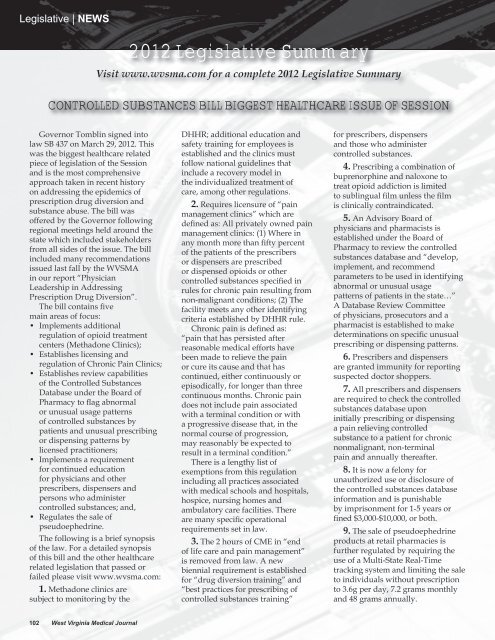Special CME Issue - West Virginia State Medical Association
Special CME Issue - West Virginia State Medical Association
Special CME Issue - West Virginia State Medical Association
You also want an ePaper? Increase the reach of your titles
YUMPU automatically turns print PDFs into web optimized ePapers that Google loves.
Legislative | NEWS<br />
2012 Legislative Summary<br />
Visit www.wvsma.com for a complete 2012 Legislative Summary<br />
Controlled Substances Bill Biggest Healthcare <strong>Issue</strong> of Session<br />
Governor Tomblin signed into<br />
law SB 437 on March 29, 2012. This<br />
was the biggest healthcare related<br />
piece of legislation of the Session<br />
and is the most comprehensive<br />
approach taken in recent history<br />
on addressing the epidemics of<br />
prescription drug diversion and<br />
substance abuse. The bill was<br />
offered by the Governor following<br />
regional meetings held around the<br />
state which included stakeholders<br />
from all sides of the issue. The bill<br />
included many recommendations<br />
issued last fall by the WVSMA<br />
in our report “Physician<br />
Leadership in Addressing<br />
Prescription Drug Diversion”.<br />
The bill contains five<br />
main areas of focus:<br />
• Implements additional<br />
regulation of opioid treatment<br />
centers (Methadone Clinics);<br />
• Establishes licensing and<br />
regulation of Chronic Pain Clinics;<br />
• Establishes review capabilities<br />
of the Controlled Substances<br />
Database under the Board of<br />
Pharmacy to flag abnormal<br />
or unusual usage patterns<br />
of controlled substances by<br />
patients and unusual prescribing<br />
or dispensing patterns by<br />
licensed practitioners;<br />
• Implements a requirement<br />
for continued education<br />
for physicians and other<br />
prescribers, dispensers and<br />
persons who administer<br />
controlled substances; and,<br />
• Regulates the sale of<br />
pseudoephedrine.<br />
The following is a brief synopsis<br />
of the law. For a detailed synopsis<br />
of this bill and the other healthcare<br />
related legislation that passed or<br />
failed please visit www.wvsma.com:<br />
1. Methadone clinics are<br />
subject to monitoring by the<br />
DHHR; additional education and<br />
safety training for employees is<br />
established and the clinics must<br />
follow national guidelines that<br />
include a recovery model in<br />
the individualized treatment of<br />
care, among other regulations.<br />
2. Requires licensure of “pain<br />
management clinics” which are<br />
defined as: All privately owned pain<br />
management clinics: (1) Where in<br />
any month more than fifty percent<br />
of the patients of the prescribers<br />
or dispensers are prescribed<br />
or dispensed opioids or other<br />
controlled substances specified in<br />
rules for chronic pain resulting from<br />
non-malignant conditions; (2) The<br />
facility meets any other identifying<br />
criteria established by DHHR rule.<br />
Chronic pain is defined as:<br />
“pain that has persisted after<br />
reasonable medical efforts have<br />
been made to relieve the pain<br />
or cure its cause and that has<br />
continued, either continuously or<br />
episodically, for longer than three<br />
continuous months. Chronic pain<br />
does not include pain associated<br />
with a terminal condition or with<br />
a progressive disease that, in the<br />
normal course of progression,<br />
may reasonably be expected to<br />
result in a terminal condition.”<br />
There is a lengthy list of<br />
exemptions from this regulation<br />
including all practices associated<br />
with medical schools and hospitals,<br />
hospice, nursing homes and<br />
ambulatory care facilities. There<br />
are many specific operational<br />
requirements set in law.<br />
3. The 2 hours of <strong>CME</strong> in “end<br />
of life care and pain management”<br />
is removed from law. A new<br />
biennial requirement is established<br />
for “drug diversion training” and<br />
“best practices for prescribing of<br />
controlled substances training”<br />
for prescribers, dispensers<br />
and those who administer<br />
controlled substances.<br />
4. Prescribing a combination of<br />
buprenorphine and naloxone to<br />
treat opioid addiction is limited<br />
to sublingual film unless the film<br />
is clinically contraindicated.<br />
5. An Advisory Board of<br />
physicians and pharmacists is<br />
established under the Board of<br />
Pharmacy to review the controlled<br />
substances database and “develop,<br />
implement, and recommend<br />
parameters to be used in identifying<br />
abnormal or unusual usage<br />
patterns of patients in the state…”<br />
A Database Review Committee<br />
of physicians, prosecutors and a<br />
pharmacist is established to make<br />
determinations on specific unusual<br />
prescribing or dispensing patterns.<br />
6. Prescribers and dispensers<br />
are granted immunity for reporting<br />
suspected doctor shoppers.<br />
7. All prescribers and dispensers<br />
are required to check the controlled<br />
substances database upon<br />
initially prescribing or dispensing<br />
a pain relieving controlled<br />
substance to a patient for chronic<br />
nonmalignant, non-terminal<br />
pain and annually thereafter.<br />
8. It is now a felony for<br />
unauthorized use or disclosure of<br />
the controlled substances database<br />
information and is punishable<br />
by imprisonment for 1-5 years or<br />
fined $3,000-$10,000, or both.<br />
9. The sale of pseudoephedrine<br />
products at retail pharmacies is<br />
further regulated by requiring the<br />
use of a Multi-<strong>State</strong> Real-Time<br />
tracking system and limiting the sale<br />
to individuals without prescription<br />
to 3.6g per day, 7.2 grams monthly<br />
and 48 grams annually.<br />
102 <strong>West</strong> <strong>Virginia</strong> <strong>Medical</strong> Journal















